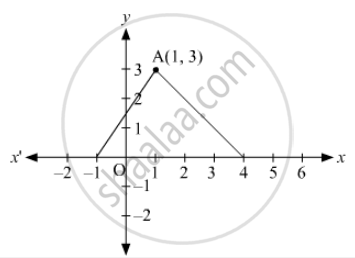Advertisements
Advertisements
प्रश्न
Find the ratio in which the point (-1, y) lying on the line segment joining points A(-3, 10) and (6, -8) divides it. Also, find the value of y.
उत्तर १
Let k be the ratio in which P(-1,y ) divides the line segment joining the points
A(-3,10) and B (6,-8)
Then ,
`(-1,y ) = ((k(6) -3)/(k+1) , (k(-8)+10)/(k+1) )`
`⇒(k(6) -3 )/(k+1) = -1 and y = (k(-8)+10)/(k+1)`
`⇒ k = 2/7`
`"Substituting " k=2/7 "in" y = (k(-8)+10)/(k+1) `, we get
`y =((-8xx2)/(7)+10)/(2/7 +1) = (-16+70)/9 = 6`
Hence, the required ratio is 2 : 7 and y=6
उत्तर २
Suppose P(−1, y) divides the line segment joining A(−3, 10) and B(6 −8) in the ratio k : 1.
Using section formula, we get
Coordinates of P = \[\left( \frac{6k - 3}{k + 1}, \frac{- 8k + 10}{k + 1} \right)\]
\[\therefore \left( \frac{6k - 3}{k + 1}, \frac{- 8k + 10}{k + 1} \right) = \left( - 1, y \right)\]
\[\Rightarrow \frac{6k - 3}{k + 1} = - 1\] and \[y = \frac{- 8k + 10}{k + 1}\]
Now,
\[\frac{6k - 3}{k + 1} = - 1\]
\[ \Rightarrow 6k - 3 = - k - 1\]
\[ \Rightarrow 7k = 2\]
\[ \Rightarrow k = \frac{2}{7}\]
So, P divides the line segment AB in the ratio 2 : 7.
Putting k = \[\frac{2}{7}\] in \[y = \frac{- 8k + 10}{k + 1}\] , we get
\[y = \frac{- 8 \times \frac{2}{7} + 10}{\frac{2}{7} + 1} = \frac{- 16 + 70}{2 + 7} = \frac{54}{9} = 6\]
Hence, the value of y is 6.
संबंधित प्रश्न
Find a point on the x-axis which is equidistant from the points (7, 6) and (−3, 4).
Show that the points A(5, 6), B(1, 5), C(2, 1) and D(6,2) are the vertices of a square.
Find the value of x such that PQ = QR where the coordinates of P, Q and R are (6, -1), (1, 3) and (x, 8) respectively.
Show that the following points are the vertices of a square:
(i) A (3,2), B(0,5), C(-3,2) and D(0,-1)
Show that the following points are the vertices of a square:
A (0,-2), B(3,1), C(0,4) and D(-3,1)
In what ratio does the line x - y - 2 = 0 divide the line segment joining the points A (3, 1) and B (8, 9)?
Find the centroid of ΔABC whose vertices are A(2,2) , B (-4,-4) and C (5,-8).
Find the possible pairs of coordinates of the fourth vertex D of the parallelogram, if three of its vertices are A(5, 6), B(1, –2) and C(3, –2).
Find the area of the quadrilateral ABCD, whose vertices are A(−3, −1), B (−2, −4), C(4, − 1) and D (3, 4).
The ordinate of any point on x-axis is
The abscissa of any point on y-axis is
If (a,b) is the mid-point of the line segment joining the points A (10, - 6) , B (k,4) and a - 2b = 18 , find the value of k and the distance AB.
Write the coordinates of the point dividing line segment joining points (2, 3) and (3, 4) internally in the ratio 1 : 5.
The distance of the point (4, 7) from the y-axis is
If points A (5, p) B (1, 5), C (2, 1) and D (6, 2) form a square ABCD, then p =
In Fig. 14.46, the area of ΔABC (in square units) is

Find the coordinates of point A, where AB is a diameter of the circle with centre (–2, 2) and B is the point with coordinates (3, 4).
What are the coordinates of origin?
If the coordinates of the two points are P(–2, 3) and Q(–3, 5), then (abscissa of P) – (abscissa of Q) is ______.
Co-ordinates of origin are ______.
